People is part of the Sustrans traffic-free routes and greenways design guide. It covers methods to ensure traffic-free routes can be used by everyone, behaviour-change campaigns and community involvement.
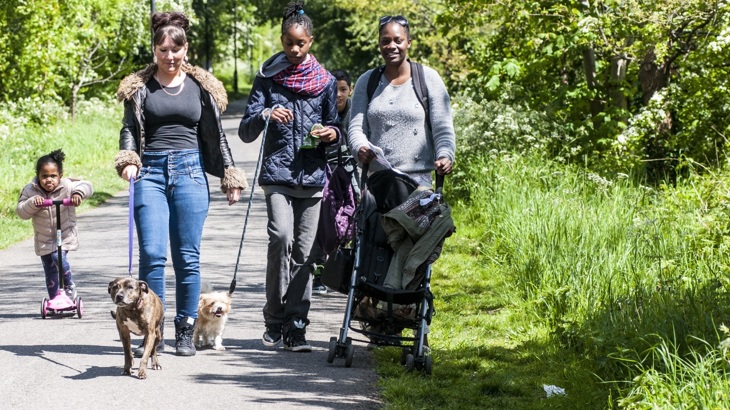
Key principles
- Ensure traffic-free routes can be used by everyone.
- In most cases, a wide range of users will share a route responsibly and considerately.
- Behaviour-change campaigns can be used to promote responsible sharing of a route.
- Community involvement is key to successful traffic-free routes.
3.1. Traffic-free route users
3.1.1
A traffic-free route must be designed on the assumption that everyone will use it. It is important to understand the challenges faced by different users, as these can affect and impede accessibility in different ways. Without understanding these challenges, a route could become a disabling environment for some users.
Designers should assume that all users will have different requirements. These requirements could change depending on the time of day, week or year. Asking the following questions can help to understand how different user requirements will effect route design:
- What measures are required to assist visually and mobility impaired users?
- What speeds will different users travel at during different times of the day or week?
- What level of confidence do users have?
- How will path surface types affect the comfort of different users?
- Is there enough width to accommodate all users?
3.1.2
Consulting representatives of user groups at an early stage of a project is critical. This will help designers to understand the challenges faced by different users. As an example, some disabled people may be able to ride a conventional bike for some distance. But if they need to dismount, they may become less mobile and encounter difficulties that able-bodied users would not.
Designers should walk and cycle through the locality of a traffic-free route to understand these challenges. Visiting sites with users of mobility scooters and adaptive bikes can also be helpful. Understanding these barriers and challenges means that they can be addressed through the design process.
3.2 Community involvement
3.2.1
Local ‘ownership’ of a traffic-free route is essential for it to be successful. The involvement of the local community in a route’s maintenance and upkeep is of particular importance. This can help to establish positive user interactions.
Without the local community’s support and a sense of ownership, the route will become less of an attraction. This will be the case even where routes are maintained to an adequate standard. Installing artwork, painted mileposts and flowerbeds can all help to involve the community and create an enjoyable and rewarding public space.
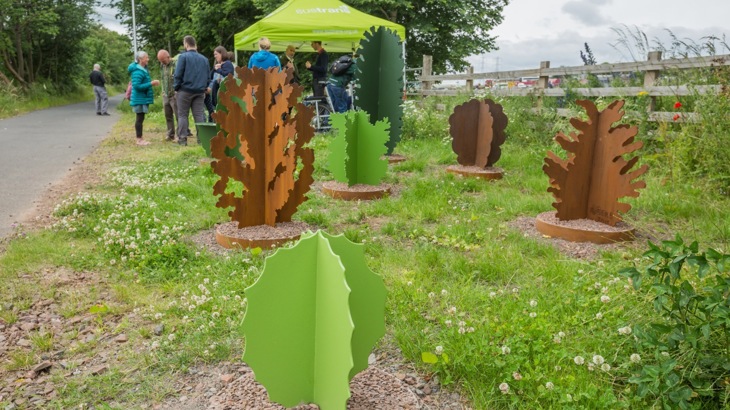
Unveiling of artwork on the Loanhead Railway Extension Path, Edinburgh
3.2.2
Community involvement should take place throughout the planning, design and delivery of a project. This can help ensure that designers are aware of community needs from the start of a project.
3.2.3
When planning community engagement, it is necessary to be clear about what the purpose is. Is it about providing and collecting information, or is it about involving people in decision making? The timing of community engagement in the development of a project is key. It is critical to manage the community's expectations to avoid misunderstandings.
3.2.4
Community engagement is an important aspect of creating an accessible and attractive route. It is important that community engagement is used to understand the needs of those who face the greatest challenges.
These users might not respond to traditional methods of consultation. As they may feel their contribution will not influence the design process, particularly as they may currently face exclusion from transport infrastructure. Furthermore, these users may not be part of, or associated with, formal advocacy groups.
This makes it even more important to ensure that community engagement is accessible to everyone. On this note, consideration must be given to differences between language, culture and opportunity. Engagement will not be effective where these differences are not considered.
Interesting and creative methods of engagement can help to reach a wider audience. These approaches can be more effective than literature-based methods. An example of an alternative engagement approach is shown below:
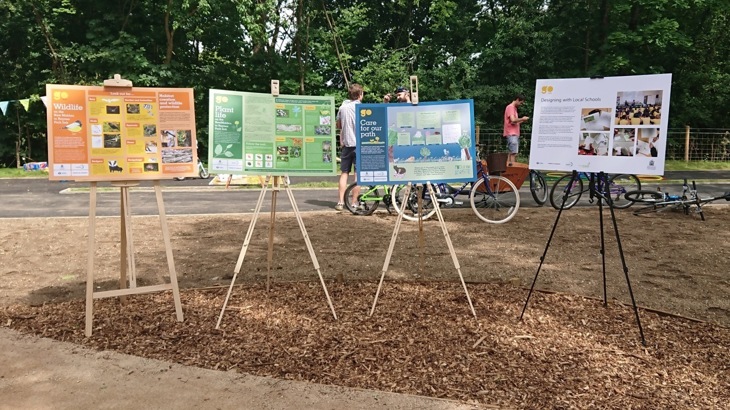
Information boards to encourage interest in route used at an open day event for the New Malden Raynes Park Scheme, London.
3.2.5
Key to successful community engagement is to identify all stakeholders. To do this, it is useful to think of who is interested in (or affected by) a project and who can influence it. The use of a matrix like the one shown below can be helpful in understanding this.
3.2.6
In some cases, there will be a need to conduct consultation, such as when a new route requires planning permission. This is also the case where schemes need Traffic Regulation Orders (TRO). In this instance, the Highway Authority will need to consult on the proposals. Although the consultation will relate to the introduction of the TRO and not the scheme itself.
When formal consultation is required, it can be beneficial to contact stakeholders in advance. Taking the views of the stakeholders into account prior to formal consultation can help to reduce the likelihood of objections, particularly when designs could be at an advanced stage.
3.2.7
Local community support for a new traffic-free route can be facilitated by the creation of a steering or planning group. The purpose of these groups is to advise upon and support the delivery of a scheme. Such a group could take a variety of forms and may involve the formation of sub-groups.
The formation of sub-groups could help optimise time and capability by focusing on specific areas such as technical design, community engagement or public relations.
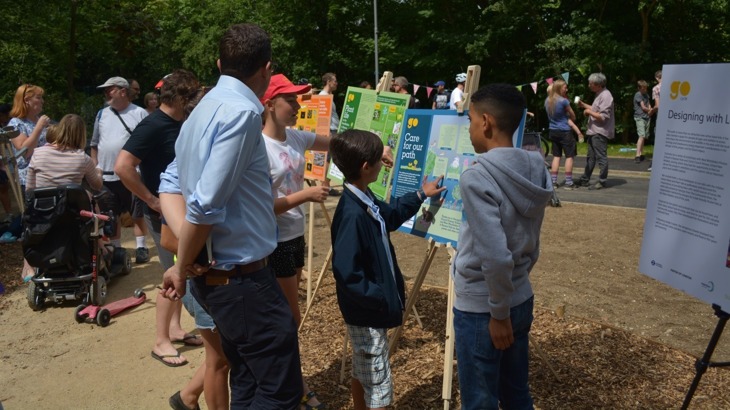
New Malden Raynes Park community engagement event used to encourage local participation and ownership of route.
3.3 Volunteers
3.3.1
The creation of a volunteer-based ‘friends of’ group can be beneficial to new and existing routes. These groups can secure ongoing functionality and use by promoting routes to the local community. Well-resourced volunteers can also undertake minor maintenance such as removing debris, vegetation clearance and cleaning sign faces.
3.4 Responsible use
3.4.1
In the majority of cases, a wide range of users can share traffic-free routes responsibly. But in some cases, inconsiderate behaviour can affect the experience of others. This behaviour may include cycling at inappropriate speeds or uncontrolled dogs. The effect of this behaviour can be exacerbated where the width of the path is less than desirable. Such reductions in width can be a result of poor design, or vegetation encroachment due to a lack of maintenance.
3.4.2
A Code of Practice can be effective in encouraging responsible sharing of a new or existing route. These can be useful where physical constraints cannot be overcome.
The creation of a Code should be developed in conjunction with the local community and can help designers to understand the obstacles to users.
This approach can be used during the planning and design stage for new routes, and also years after the implementation of a route where use has increased and physical improvements are no longer possible.
A Code of Practice should be founded on the principle of access for everyone. It should also ensure that all users share the route responsibly. Previous successful campaigns have included the use of ‘share with care’ and ‘share, respect, enjoy’ slogans.
It is important that a Code does not attribute the misuse of a route to a specific user group. Instead, it should focus on promoting responsible behaviour.
3.4.3
For a Code of Practice to be successful, it will need to be communicated to all users of a traffic-free route. This may include engagement events with route users and displaying the Code of Practice on signs or thermoplastic markings as shown below:
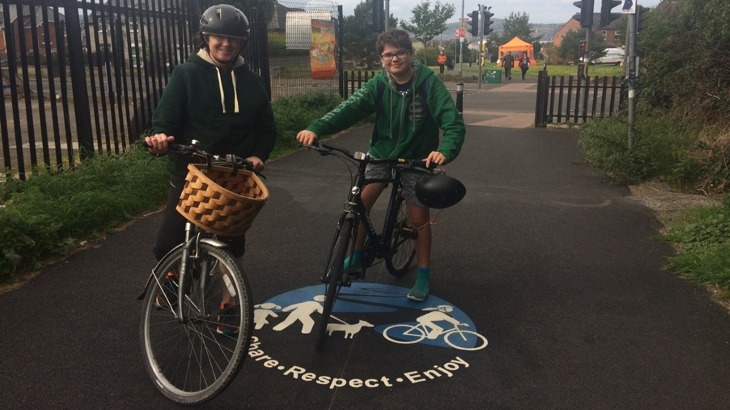
Share, Respect, Enjoy thermoplastic marking used on the Comber Greenway, Northern Ireland.
3.5 One Path initiative
3.5.1
The One Path Initiative is aimed at tackling conflict on traffic-free routes. The principles of the initiative are to share, respect and enjoy routes, promoting and enhancing positive sharing behaviours.
This initiative was developed as an alternative to physical signing. It focuses on behaviour change rather than rules and regulations. It also seeks to improve communications and understanding between route users. It achieves this goal by:
- Understanding who uses the traffic-free route and their individual needs.
- Improving relations amongst the users.
- Reducing conflict and thereby complaints.
- Avoiding physical interventions and / or permanent signing and the resulting expense.
- Ensuring route management agencies deliver consistent messages.
The One Path Initiative has been applied to established routes. But its principles can also be applied to routes at the planning and design stage. Applying the principles at this stage can reduce the need for unnecessary signing and control devices.
3.5.2
The One Path Initiative is based on a three-stage delivery programme. The programme focuses on promoting equality and awareness amongst users. This approach was found to result in positive cultural and behavioural change.
The strategy relies upon a community assembled Stewardship Group. This group provides residents and stakeholders with a platform from which to influence project initiatives and balance the needs of all users.
3.5.3.
Stage 1: Enable research and surveys to be undertaken. These will help to understand user behaviour, path usage and conflict areas. It is important to understand initial attitudes of users, focusing on three main areas:
- To understand the path usage patterns and identify when potential conflict is more likely to occur.
- Find out the most common use of the traffic-free route, in particular whether it is used for leisure or commuting.
- To understand the issues and attitudes of all users.
The surveys required to complete this monitoring should be included within a Monitoring and Evaluation Plan, produced at the onset of a project.
Stage 2: Following the survey, it is possible to identify the main target audience. Separate focus groups are held for each of the key audiences. This enables an open discussion and exploration of each group’s experiences of using the route.
With all the information gathered, seek to organise community engagement events focused at target audiences in carefully selected locations. This aims to give all users the chance to take part in shaping the debate, co-creating the campaign, giving a sense of ownership and inclusion, all aiming to adjust behaviours in a positive way.
Stage 3: Develop a bespoke action plan to include the following:
- Ongoing communications plan.
- Template for website communications.
- On-path signing guidance.
- Extended programme of regular face-to-face engagement events with support from stakeholders.
- Ongoing monitoring of behaviour.
Infrastructure improvements to be identified and costed, and an actioned communications plan would be developed and delivered by the team and supported by stakeholder communications:
- Objective 1: Raise awareness and invite to focus groups.
- Objective 2: Promotion of engagement events.

